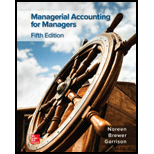
1.
Introduction:
Break-even point:
Break-even point is defined as the volume of production where the total cost is equal to the total sales revenue generated thereby resulting in a no-
To calculate the break-even point in unit sales and dollar sales.
2.
Introduction:
Break-even point:
Break-even point is defined as the volume of production where the total cost is equal to the total sales revenue generated thereby resulting in a no-profit and no loss situation. At the break-even point, the contribution earned is sufficient to cover the costs, whereas if the contribution is less than the break-even point then it is a loss and if it is more, then it is a profit.
To determine whether increasing the variable expenses as a percentage of the selling price will result in a higher or lower break-even point.
3.
Introduction:
Break-even point:
Break-even point is defined as the volume of production where the total cost is equal to the total sales revenue generated thereby resulting in a no-profit and no loss situation. At the break-even point, the contribution earned is sufficient to cover the costs, whereas if the contribution is less than the break-even point then it is a loss and if it is more, then it is a profit.
To prepare: two contribution format income statements with present operating conditions and the proposed changes.
4.
Introduction:
Break-even point:
Break-even point is defined as the volume of production where the total cost is equal to the total sales revenue generated thereby resulting in a no-profit and no loss situation. At the break-even point, the contribution earned is sufficient to cover the costs, whereas if the contribution is less than the break-even point then it is a loss and if it is more, then it is a profit.
To calculate: the number of stoves to be sold at the new selling price given in requirement 3 to attain a target profit of $ 35000 per month.
Want to see the full answer?
Check out a sample textbook solution
Chapter 2 Solutions
Managerial Accounting for Managers
- I am looking for the correct answer to this general accounting question with appropriate explanations.arrow_forwardI don't need ai answer general accounting questionarrow_forwardOwner's equity for Voltaire Enterprises is $1,250,000, and total liabilities are $500,000. The company paid $75,000 in dividends during the year. What do the total assets equal?arrow_forward
- if value is not showing properly then please comment i will write values don't solve with incorrect values i will mark as unhelpful.arrow_forwardWhat would be the effect on income from operations if absorption costing is used rather than variable costing?arrow_forwardWhat is the amount of overapplied or underapllied overhead?arrow_forward
- Please provide the correct answer to this general accounting problem using accurate calculations.arrow_forwardCan you explain the steps for solving this financial accounting question accurately?arrow_forwardAgni Corporation's net income for the year is $490,000. On June 30, a $0.75 per share cash dividend was declared for all common stockholders. Common stock in the amount of 40,000 shares was outstanding at the time. The market price of Agni's stock at year-end is $18 per share. Agni had a $1,200,000 credit balance in retained earnings at the beginning of the year. Required: Calculate the ending balance of retained earnings. Answerarrow_forward
- Ash Merchandising Company expects to purchase $88,000 of materials in July and $120,000 of materials in August. Three-quarters of all purchases are paid for in the month of purchase, and the other one-fourth are paid for in the month following the month of purchase. How much will August's cash disbursements for materials purchases be?arrow_forwardWhite Co. incurs a cost of $17 per pound to produce Product X, which it sells for $25 per pound. The company can further process Product X to produce Product Y. Product Y would sell for $31 per pound and would require an additional cost of $15 per pound to be produced. The differential cost of producing Product Y is: a. $15 per pound b. $26 per pound c. $13 per pound d. $10 per poundarrow_forwardWhat is the direct labor price variance for September ?arrow_forward

 AccountingAccountingISBN:9781337272094Author:WARREN, Carl S., Reeve, James M., Duchac, Jonathan E.Publisher:Cengage Learning,
AccountingAccountingISBN:9781337272094Author:WARREN, Carl S., Reeve, James M., Duchac, Jonathan E.Publisher:Cengage Learning, Accounting Information SystemsAccountingISBN:9781337619202Author:Hall, James A.Publisher:Cengage Learning,
Accounting Information SystemsAccountingISBN:9781337619202Author:Hall, James A.Publisher:Cengage Learning, Horngren's Cost Accounting: A Managerial Emphasis...AccountingISBN:9780134475585Author:Srikant M. Datar, Madhav V. RajanPublisher:PEARSON
Horngren's Cost Accounting: A Managerial Emphasis...AccountingISBN:9780134475585Author:Srikant M. Datar, Madhav V. RajanPublisher:PEARSON Intermediate AccountingAccountingISBN:9781259722660Author:J. David Spiceland, Mark W. Nelson, Wayne M ThomasPublisher:McGraw-Hill Education
Intermediate AccountingAccountingISBN:9781259722660Author:J. David Spiceland, Mark W. Nelson, Wayne M ThomasPublisher:McGraw-Hill Education Financial and Managerial AccountingAccountingISBN:9781259726705Author:John J Wild, Ken W. Shaw, Barbara Chiappetta Fundamental Accounting PrinciplesPublisher:McGraw-Hill Education
Financial and Managerial AccountingAccountingISBN:9781259726705Author:John J Wild, Ken W. Shaw, Barbara Chiappetta Fundamental Accounting PrinciplesPublisher:McGraw-Hill Education





